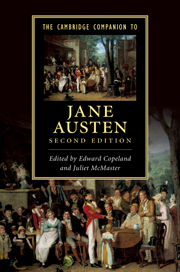Book contents
- Frontmatter
- 1 The Professional Woman Writer
- 2 Northanger Abbey And Sense And Sensibility
- 3 Pride And Prejudice And Mansfield Park
- 4 Emma And Persuasion
- 5 The Early Short Fiction
- 6 ‘Lady Susan’, ‘The Watsons’ And ‘Sanditon’
- 7 The letters
- 8 Class
- 9 Money
- 10 Making a living
- 11 Gender
- 12 Sociability
- 13 Jane Austen and literary traditions
- 14 Jane Austen on screen
- 15 Austen cults and cultures
- 16 Further reading
- Index
- Cambridge Companions to . . .
12 - Sociability
Published online by Cambridge University Press: 28 March 2011
- Frontmatter
- 1 The Professional Woman Writer
- 2 Northanger Abbey And Sense And Sensibility
- 3 Pride And Prejudice And Mansfield Park
- 4 Emma And Persuasion
- 5 The Early Short Fiction
- 6 ‘Lady Susan’, ‘The Watsons’ And ‘Sanditon’
- 7 The letters
- 8 Class
- 9 Money
- 10 Making a living
- 11 Gender
- 12 Sociability
- 13 Jane Austen and literary traditions
- 14 Jane Austen on screen
- 15 Austen cults and cultures
- 16 Further reading
- Index
- Cambridge Companions to . . .
Summary
The primary definition of sociability in the Oxford English Dictionary is ‘the character or quality of being sociable, friendly disposition or intercourse’. Jane Austen’s fiction represents one of the most sophisticated analyses we have of the elusive ‘character or quality’ of sociable human interaction – its joys as well as its pains. Yet the importance of this topic in her work, indeed how it is constitutive of her greatest achievement, has rarely been fore-grounded in Austen studies. The tendency has been to treat the many references to social activity in the novels, such as balls, visits, walks, shopping, concerts or theatricals, as part of the customs or pastimes of the age which the fiction merely reflects rather than deliberately analyses.
This approach is apparent in R. W. Chapman’s seminal edition with appendices on customs such as dancing, a practice of annotation which continues in some editions of the novels today. It is also evident in the numerous book and website guides to Austen’s regency world which detail the niceties of Georgian social etiquette. The sense of the sociable rituals of Austen’s fiction as reflecting a world which we in the twenty-first century have lost and wistfully hanker for is crucial to explorations of the contemporary cult of Austen in The Jane Austen Book Club or the television drama Lost in Austen. It manifests itself most strikingly in the current fashion for Austen regency balls, in which, like British and US civil war re-enactments, men and women dance out fantasies of ‘becoming Jane’ or Mr Darcy. Such occasions, taking place across the world, from Cheltenham to Canberra, register a nostalgic alienation from Jane’s world and its irrevocable pastness.
- Type
- Chapter
- Information
- The Cambridge Companion to Jane Austen , pp. 176 - 191Publisher: Cambridge University PressPrint publication year: 2010
- 1
- Cited by



